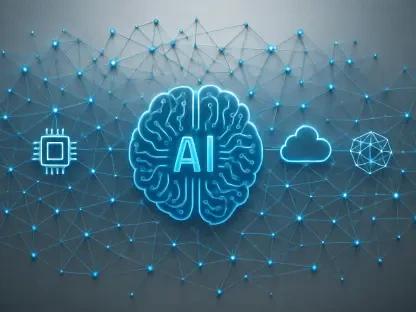As technology advances, the debate between local AI processing on AI PCs and cloud-based AI solutions becomes more intense, particularly with projections set for 2025. Despite initial promises of enhanced performance and improved privacy, AI PCs are struggling to capture a significant market share, evident with sales increasing only marginally by around 1% in the fourth quarter of 2024. This leaves us questioning whether local processing can indeed surpass cloud capabilities within a near-future timeframe.
The ability of AI PCs to handle AI tasks locally effectively ensures that users have faster processing for activities such as video editing or report summarizing while maintaining their privacy. Major technology companies like AMD and Intel spearhead this innovation with advanced chips like AMD’s Ryzen AI Max and Intel’s Core Ultra 200V, specifically designed to enhance commercial laptops through powerful neural processing units. Nevertheless, despite technological strides, enthusiasm among consumers and businesses remains lukewarm, reflecting skepticism on whether these solutions can distinctly outshine current cloud-based AI services.
The Promise of Local AI Processing
AI PCs propose a future where tasks traditionally reliant on cloud services can be handled locally, offering advantages in both performance and privacy. By managing AI tasks directly on the hardware, users might experience swifter execution of complex processes such as video editing and report summarization without depending on external servers. Companies like AMD are at the forefront with innovations like the Ryzen AI Max chip, touting robust neural processing capabilities designed to boost local AI performance. Similarly, Intel’s Core Ultra 200V aims to enhance commercial laptops by embedding powerful AI functionalities centrally.
Despite these promising advances, the market reaction remains mostly tepid. This market response is reflected in the marginally rising sales figures, which only saw a growth of about 1% in late 2024. Such figures strongly suggest that consumers and businesses aren’t fully convinced of local AI processing’s benefits over established cloud-based solutions. The slow adoption implies a potential hesitation based on unknown trade-offs, from cost considerations to actual performance metrics, when compared side by side with cloud services known for their reliability and accessibility.
Barriers to Adoption
Among the primary barriers to broader adoption of AI PCs is the absence of persuasive AI applications that demonstrate significant superiority when executed on local hardware versus cloud platforms. Current AI services like ChatGPT or Midjourney are already incredibly efficient and provide wide accessibility through the cloud, creating robust competition for local alternatives. This competition makes it challenging for AI PCs to carve out a niche that can demonstrate a clear and distinct advantage over their cloud-based counterparts.
Another challenge is the concern over privacy, typically a selling point for local processing. However, robust security measures are already in place for online transactions and communications, which effectively mitigate these privacy concerns to an extent. As a result, many users feel confident that their AI processing tasks will remain secure when managed in the cloud, reducing the perceived necessity for local AI processing to ensure privacy. This poses a significant hurdle for AI PC adoption, as the emphasis on privacy as a unique selling point may not be sufficiently compelling in the current landscape.
Learning from the Gaming Industry
Insights can be drawn from the gaming industry’s trajectory, where high-performance gaming PCs and consoles remain preferred despite the availability of cloud gaming options. The demand for seamless and uninterrupted performance has made powerful local hardware standard among gaming enthusiasts. This trend underscores the appeal and critical importance of local processing power, a vital principle that Nvidia capitalized on with the launch of the GeForce RTX 50 series graphics cards. Nvidia’s innovation brings AI-driven enhancements, like “frame filling,” boosting game visuals by generating additional frames through pre-trained AI models.
Nonetheless, this integration of AI into gaming is not without its challenges. As exciting as these developments are, their adoption hinges on delivering compelling user experiences that current AI applications fall short of providing. Most desktop applications, ranging from Microsoft Office to Adobe’s suite, have transitioned online, shifting processing responsibilities to servers rather than local machines. These changes pose additional challenges for PC makers, who must demonstrate the compelling benefits of running AI locally, a task easier said than done.
The Need for Compelling AI Applications
For AI PCs to truly become an essential part of the technological landscape, new AI applications need to emerge, showcasing significantly better performance when run locally versus through cloud computing. AI applications that streamline video generation or facilitate personalized AI model training for particular tasks could become crucial drivers of this adoption. However, until such applications arrive and gain traction, the principle from the 1990s, stating “the network is the computer,” remains relevant. Cloud computing continues to dominate where data processing and intensive number crunching are concerned.
User preference divergence between cloud and local processing engenders the performance spectrum across various hardware configurations. Streamlining AI operations to optimize performance across different systems and creating appealing and high-performance AI applications for local use will be pivotal for AI PCs to carve out a substantial market share. Presently, AI PCs are a niche product, their full potential yet to be realized. These advancements are contingent upon further breakthroughs in AI application development and better integration with local hardware to deliver a seamless and optimized user experience.
The Future of AI PCs
As technology advances, the debate between local AI processing on AI PCs and cloud-based AI solutions grows more heated, especially with predictions for 2025. AI PCs, once promised to deliver superior performance and better privacy, have not gained significant market traction, with a mere 1% increase in sales in the fourth quarter of 2024. This modest growth raises doubts about whether local AI processing can truly surpass cloud capabilities soon.
AI PCs offer the benefit of handling AI tasks locally, providing faster processing for activities like video editing or report summarizing while ensuring user privacy. Leading tech companies such as AMD and Intel are at the forefront of this innovation, developing advanced chips like AMD’s Ryzen AI Max and Intel’s Core Ultra 200V, which are geared to enhance commercial laptops with powerful neural processing units. Despite these technological advancements, interest from consumers and businesses remains tepid, signaling skepticism regarding whether these solutions can genuinely outperform existing cloud-based AI services.









